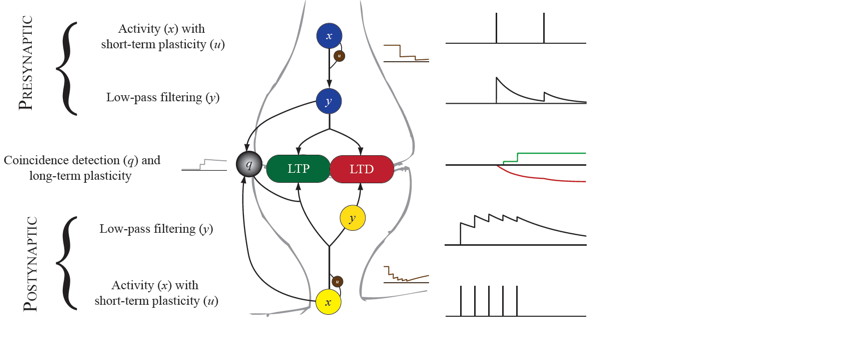Adaptation and Learning
One core hypothesis in Neuroscience is that memories become encoded in the plastic synapses of the brain: Daily experience reshapes existing connection, thus forming new memories, but also changing or erasing older ones. Since the seminal work of Donald Hebb in 1949, many ideas have emerged how and why synapses actually change, but there is still no coherent, general framework which would describe synaptic change in a quantitative manner. The reason is that synapses are notoriously hard to monitor in the living brain, and hence our knowledge of what is really going on is still sketchy.
Our own research interests are twofold: First, we aim at an understanding of synaptic plasticity at the single synapse level. Here we study systems of two neurons connected by a synapse, which are subjected to different stimulation protocols. Depending on the timing and statistics of stimulation, the efficacy of the synapse changes, and the transmission properties of the system are modified. Second, we investigate how synaptic plasticity changes the behaviour of a (recurrent) neural network as a whole. In particular, we are interested in the link between how spike-timing dependent plasticity and reinforcement learning.
Dynamics of Spike Timing Dependent Plasticity
Several years ago, it has been observed that the temporal order of neuronal activity is a major determinant of the direction and magnitude of synaptic change. Presynaptic before postsynaptic spiking leads to synaptic potentiation, whereas the reverse order of events leads to synaptic depression. These phenomena are subsumed under the term Spike Timing Dependent Plasticity (STDP), and their consequences on learning studied in a large number of theoretical investigations.
However, the common implementation of STDP does not take into account nonlinear effects, but simply generalizes findings for spike pairs to arbitrary spike trains. We think that the errors between experimental data and model predictions resulting from this approach are too large to ignore. Instead, we explicitly model pre- and postsynaptic contributions to synaptic change with a dynamics similar to synaptic short term depression. The resulting model retains a simple mathematical structure, which makes it suitable for large scale simulations and analytical treatment, but at the same time fits a much wider range of experimental findings.

